WORLD CLASS COACHING
30 Transition Rondos
By Luca Bertolini
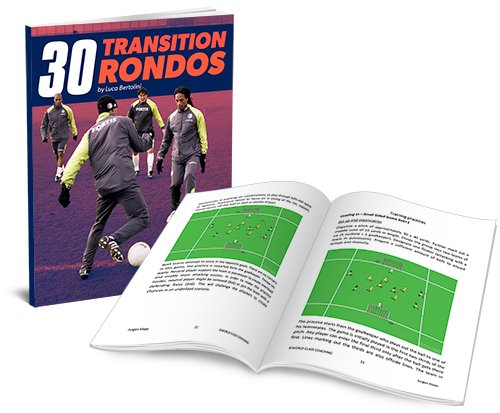
Table of Contents
PART THREE
THREE-GRID RONDOS
Three Grid Rondos
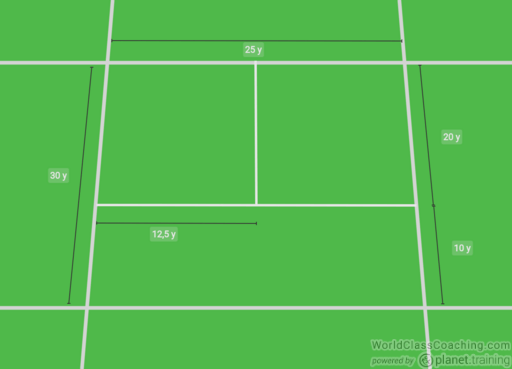
Exercise 24: 2 v 2 + 1, double 1 v 1 duel and same transitions phases
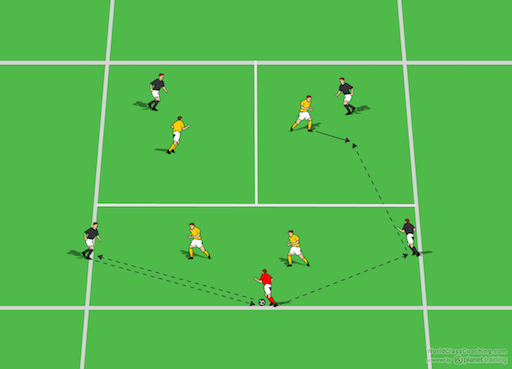
Sequence
The playing space is divided into three areas; one horizontal lower area and two upper and vertical ones. Two black players are placed along the borders of the lower area and two defenders are inside it.
One neutral player is placed along the borderline of the main rectangle as lower vertex. Two other black players (outside) and two defenders (inside) are placed in the upper areas in a double 1 v 1 duel.
The objective for the players in possession is to play a wall passing combination on one side of the lower area (on the left in the picture) and then to switch the side (on the right) against two defenders who are pressing. The forward inside the upper area should be able to receive, control the ball and pass back to switch the side.
The defenders inside the lower area are asked to close the forward passing lanes and the other two must put direct pressure against the opponents to win the possession. The first objective should be to anticipate the attacker or to press him on the ball control, to prevent him from passing the ball back.
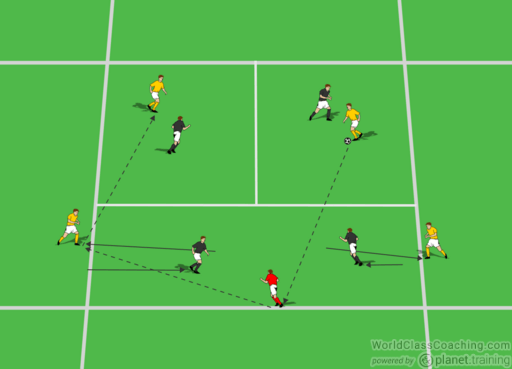
Transitions
Tta: if one defender wins the ball, wherever the ball is won, he must play a back pass to the neutral player to start the sequence again. The teammates inside the lower area must move wide to be option and the others inside the upper areas must move to be free from the markers. Ttd: The black players inside the lower area must move inside to close the easiest wide passing lanes to the neutral player now in possession. The other two inside the upper area must mark the opponents on.
Eye on: close the passing lanes, mark the man on or anticipate him, quick wide runs to be an option.
Exercise 25: 2 v 2 + 1, double 1 v 1 + 1 duels and 2 v 1 transitions
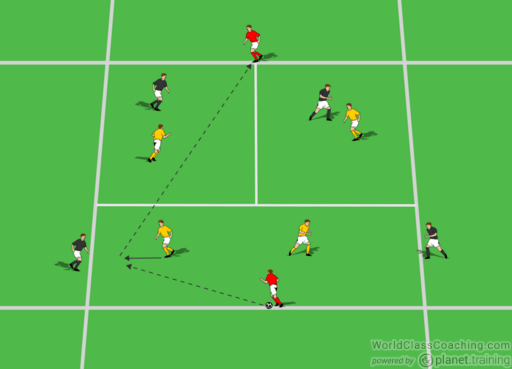
Sequence
The playing space is divided into three areas; one horizontal lower area and two upper and vertical ones. Two black players are placed along the borders of the lower area and two defenders are inside it.
One neutral player is placed along the borderline of the main rectangle as lower vertex; a second one is place to be an upper vertex between the vertical areas. Two other black players (outside) and two defenders (inside) are placed in the upper areas in a double 1 v 1 duel.
The objective for the players in possession is to play a wall passing combination on one side of the lower area (on the left in the picture) and then to switch the side (on the right) against two defenders who are pressing. The forward inside the upper area should be able to receive, control the ball and pass forward to the upper neutral player to switch the side and play another sequence to play back and start again.
The defenders inside the lower area are asked to close the forward passing lanes and the others can choose if to put direct pressure against the opponents to anticipate them to win the possession or if to close the passing lanes toward the upper vertex only.
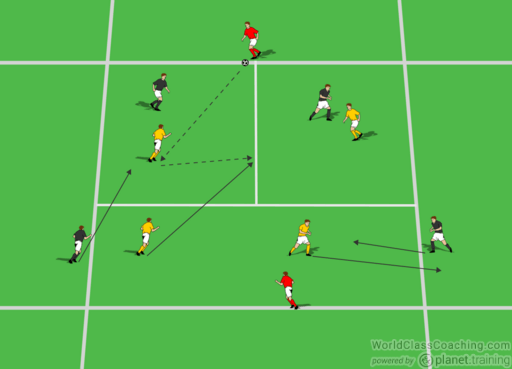
Transitions
Tta: if one defender wins the ball, wherever the ball is won, he must play a forward pass to the upper neutral player to start the sequence again. One player must run inside an upper area from the lower one to create a momentary 2 v 1 duel to save the possession. The second yellow player must move wide to be option in the lower area. The goal is to play the ball the lower neutral player and start the sequence again. Ttd: The black player near the moving forward opponent must follow him to equalize the duel 2 v 2. The second black player must run inside the lower area to close the back passing lanes; the last defender must mark the man on.
Eye on: exploit the momentary numerical advantage, equalize the outnumbered situations quickly, close the passing lanes, move wide to be an option.
Exercise 26: 2 v 2 + 1, double 1 v 1 + 1 duels and 2 v 2 + 1 transitions
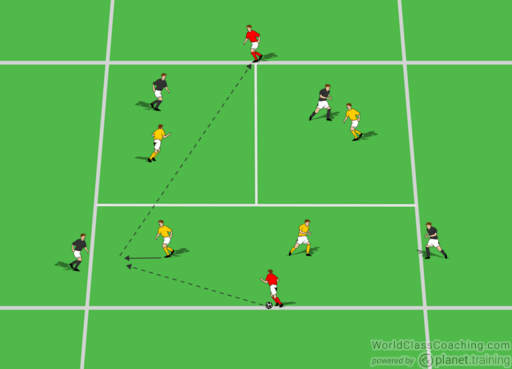
Sequence
The playing space is divided into three areas; one horizontal lower area and two upper and vertical ones. Two black players are placed along the borders of the lower area and two defenders are inside it.
One neutral player is placed along the borderline of the main rectangle as lower vertex; a second one is place to be an upper vertex between the vertical areas. Two other black players (outside) and two defenders (inside) are placed in the upper areas in a double 1 v 1 duel.
The objective for the players in possession is to play a wall passing combination on one side of the lower area (on the left in the picture) and then to switch the side (on the right) against two defenders who are pressing. The forward inside the upper area should be able to receive, control the ball and pass forward to the upper neutral player to switch the side and play another sequence to play back and start again.
The defenders inside the lower area are asked to close the forward passing lanes and the other can choose if to put direct pressure against the opponents to anticipate him, to prevent him from passing the ball forward and to win the possession or if to close the passing lanes toward the upper vertex only.
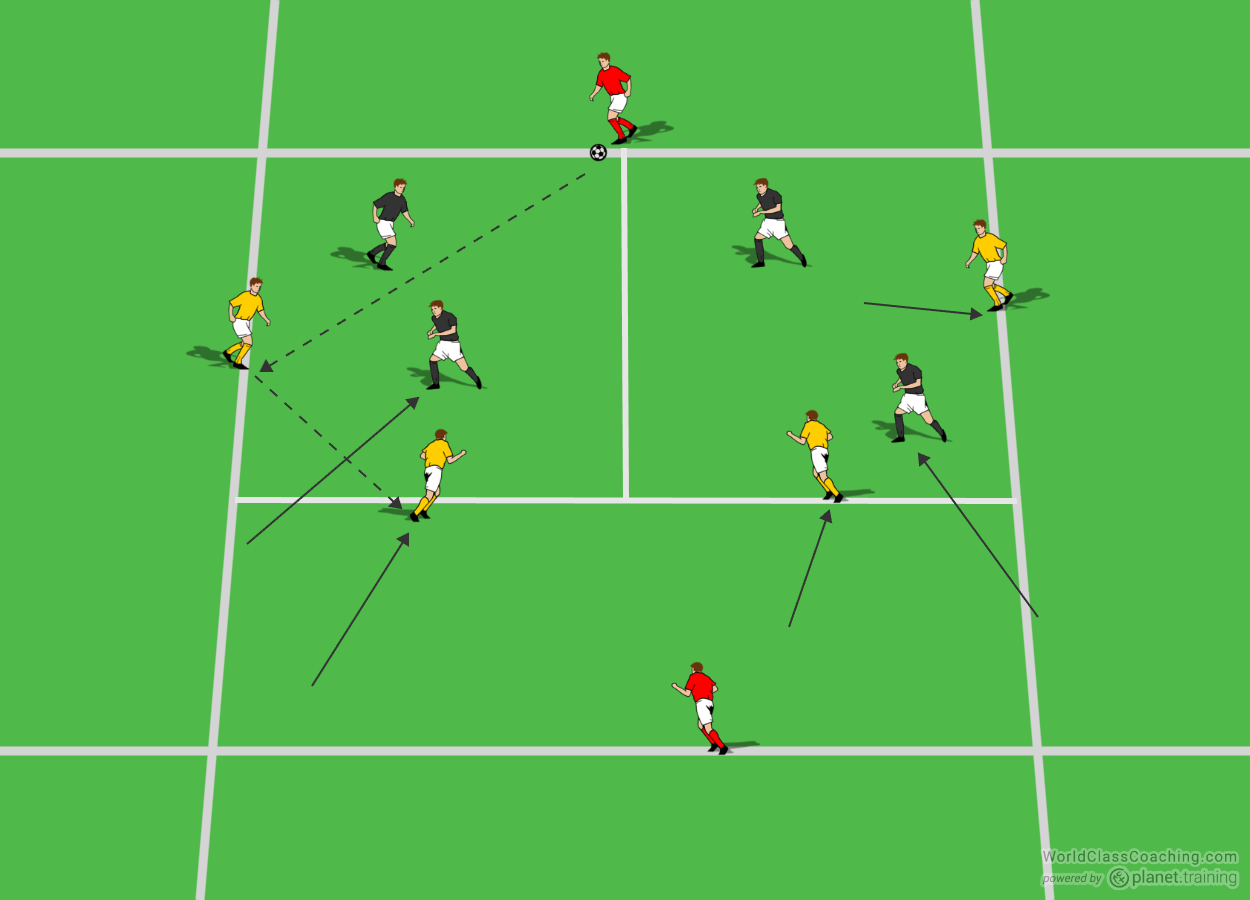
Transitions
Tta: if one defender wins the ball, wherever the ball is won, he must play a forward pass to the upper neutral player to start the sequence again. All the other players must run forward: the yellow one must be placed along the upper rectangle to keep he possession safe, as in the picture. Ttd: the black players must move inside the upper areas (two inside each zone) to defend in the double 2 v 2 + 1 duels.
Tta - 2: if they recover the ball, they must play a back pass to the lower neutral player to start the sequence again.
Eye on: defend forward, close the passing lanes, move forward to keep the possession as it's recovered, move wide to make the possession safe.
Exercise 27: 4 v 3 and 2 v 2 + 1 duels and 5 + 1 v 4 transition
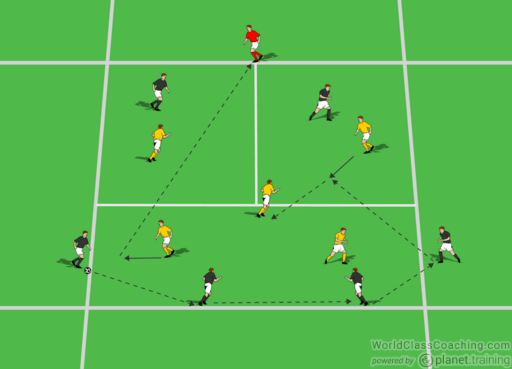
Sequence
The playing space is divided into three areas; one horizontal lower area and two upper and vertical ones. Four black players are placed along the wide and lower borders of the horizontal area as a line of four midfielders. Three defenders are inside there. One neutral player is placed along the upper borderline of the main rectangle as lower vertex. Two other black players and two defenders are placed in the upper areas in a double 1 v 1 duel; the forward should receive the ball behind the defenders.
The objective for the players in possession is to play from one side of the lower area (from the left to right in the picture) and then to play forward (on the right in picture) against three defenders who are pressing. The forward inside the upper area should be able to receive, control the ball and pass forward to the upper neutral player to switch the side and play another sequence to play back and start again.
The defenders inside the lower area are asked to close the forward passing lanes and the others can choose if to put direct pressure against the opponents to anticipate them to win the possession or if to close the passing lanes toward the upper vertex only.
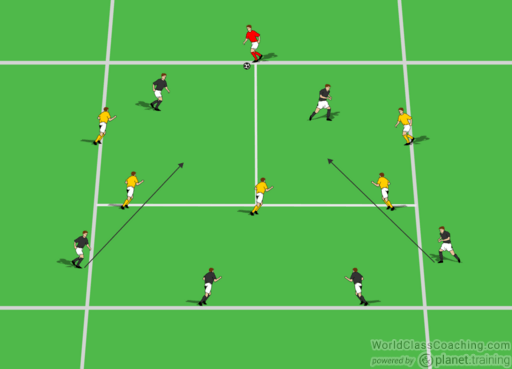
Transitions
Tta: if one defender wins the ball, wherever the ball is won, he must play a forward pass to the upper neutral player to start the sequence again. All the other players must run forward: the yellow one must be placed along the upper rectangle to keep he possession safe, as a line of five midfielders (three center ones and two wide). The main goal is to keep the possession inside the upper part of the main rectangle. Ttd: the outer black players must move inside the upper areas (one inside each zone) to help their teammates to defend in the double 3 v 2 + 1 duels and a general 5 + 1 v 4 duel.
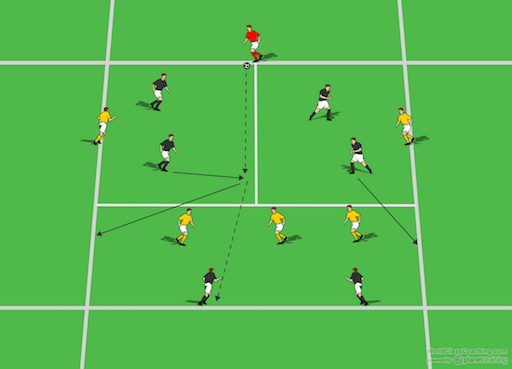
Tta - 2: if they recover the ball, they must play a back pass to center back players, two of them must move back and wide to start the 4 v 3 sequence again.
Eye on: defend forward, close the passing lanes, move forward to keep the possession as it's recovered, move wide to make the possession safe.


